James A Watson
-
- A Look into ABS with James Watson Marine News, Jan 2014 #12
When ABS, the global provider of maritime classification services, announced that James A. Watson had been named President and Chief Operating Officer of their Americas Division, it wasn’t hard to see why. Likewise, there were few if any other candidates for the job with as well rounded a CV, and with the breadth of knowledge spanning the full range of maritime issues. Formerly the Director of the Bureau of Safety and Environmental Enforcement (BSEE) and before that, Watson served as the U.S. Coast Guard’s Director of Prevention Policy for Marine Safety, Security and Stewardship, where his responsibilities included commercial vessel safety and security, ports and cargo safety and security and maritime investigations. Notably, he was designated as the Federal On-Scene Coordinator for the government-wide response to the Macondo oil spill in the Gulf of Mexico in June 2010. Beyond this, Watson graduated in 1978 from the U.S. Coast Guard Academy with a Bachelors of Science degree in Marine Engineering and holds Master of Science degrees from the University of Michigan in Mechanical Engineering and Naval Architecture in addition to a Master’s degree in Strategic Studies from the Industrial College of the Armed Forces. Based at the ABS Division’s headquarters in Houston, Watson hit the ground running in September. Read on to see what he’s been up to since:
You’ve been on board at ABS now for four months and this assignment follows two other similarly high profile, c-level assignments at both BSEE and the U.S. Coast Guard. What’s different about each of these posts, what is the same and what “take-aways” from the previous posts will you bring to ABS in your new role?
ABS’ mission is to promote the common safety, while the Coast Guard and BSEE naturally follow a regulatory approach. Despite the different approaches, they have similar goals and a similar heritage. They exist to serve the maritime industry and the public interest by working to reduce the likelihood of accidents and improve working conditions at sea. Each is built on a foundation of sound standards, highly competent engineers and field professionals, and a genuine interest in the success of the maritime industry. As a Coast Guard officer, my job involved maritime response as well as prevention. While I was at BSEE, I embraced its safety and conservation mission, which is strongly linked to natural resource management. At ABS, I have added the objective of serving the maritime and offshore industries by helping them meet their desire to run a safe ship or rig while managing costs and downtime. Coming from Coast Guard and BSEE, I bring a conviction to achieving safety through a balanced, risk-based approach. I’m convinced that good ship management and seamanship are critical, but I also believe in the value of experienced engineers and surveyors. I believe leading indicators precede every accident; so safety is a matter of collectively reading the indicators and taking action at the right time.
Safety evolves over time – in the Coast Guard, in the commercial world, at BSEE and – at ABS. In all four worlds, safety also involves managing risk. All four approach the challenge a little differently. Your perspective brings them all together. How so?
Maritime professionalism, established standards and protocols, and a constant respect for changing risk conditions are essential for safety. My strategy encompasses all three, and I believe Coast Guard, BSEE, ABS, and commercial operators all have obligations to do their part. Since these organizations are large, widely spread, and usually focused on technical details, there’s value in having someone to strengthen the common ground. I envision having that role. My new position at ABS is ideal because of the added responsibility I have to the commercial operators and marine industry leadership. While government leadership is well defined, industry leadership can be pretty diverse. I pride myself in being both a listener and a communicator. So, I hope I can be a good conduit for information and understanding. I believe reason and consensus can prevail in every difficult vessel construction and maintenance decision. Safety, environmental protection, and efficient commerce are in everyone’s interest. As president of the ABS Americas Division, I plan to emphasize the many agreements and practices that these organizations already share in order to form the new policies and practices we will need to keep the industry moving forward. When industry moves to new environmental standards or embraces more efficient technology, we have to also consider the safety of the asset, its cargo or the crew. It is essential to fully understand risk tradeoffs as we begin implementing innovative technologies so the best informed decisions are taken across the board.Give us some examples.
An example is mitigating risks that can be unintentionally introduced by installing equipment or systems necessary for compliance with particular environmental regulations or in the interest of energy efficiency. Class is taking a more holistic approach to the role of defining safety. In many cases, that means addressing areas that are not specifically covered by statutory regulations, such as equipment integrity, redundancy, equipment safety, operational safety and aspects of maintenance. Increasingly we are required to provide some type of formal safety assessment as a condition of classification approval of certain onboard installations. Today’s technology, knowledge and experience, and the availability of performance data are providing the foundation for a new, more effective approach to safety. We know that the next generation of maritime regulations is going to be driven by data to a degree that has not been seen before. The challenge of big data is selecting the “right” data from the data flow to develop a data-driven classification cycle, which replaces the calendar-based approach to class and regulatory surveys that has been with us for more than 200 years. I am pleased to see and be a part of this transformation. Corporate leaders have the opportunity to act as role models for safety and safety culture. This happens through direct action – providing resources of time, personnel and money as well as empowering workers to work safely. This type of commitment helps to create an environment of mutual trust and is the keystone of a positive safety culture. ABS is this type of leader.
The Arctic is a focus of the Coast Guard, ABS and BSEE, all arguably for different reasons. Change is coming quickly there. Are Class, the regulatory and commercial sectors ready for what comes next?
The Arctic is a frontier. Americans excel in frontier adventures and have played a role in introducing technologies that allow entrance into frontiers. We also need to protect the natural environment in the Arctic – the culture and lifestyle of the people living there – and provide a level playing field for everyone participating in development. The harsh environment, the damaging potential of thick ice, and the remoteness of the Arctic are challenges each organization is addressing. Coast Guard, BSEE, ABS and the marine industry rely on one another to do what they do best in a situation like the Arctic. While more work is needed to improve navigational safety and shipboard safety equipment, the Coast Guard has had success working with Arctic nations on protocols for search and rescue and environmental response. BSEE is leading the industry and the other Arctic nations in promoting new safeguards for ice scouring, ice management, and blowout prevention and response. ABS joins in the pursuit of safe Arctic operations through investment in R&D, establishing a harsh environment center in Canada for that purpose. And ABS has developed cold weather and ice strengthening vessel construction standards. Certainly, more work will be needed, but it’s important that all three service organizations stay in lockstep with industry. The industry is keenly aware of the risks and the rewards of operating in the Arctic. I’m confident that measured, risk-based steps will precede each step in developing the Arctic’s potential for more efficient global transportation and for new sources of plentiful energy.
LNG: ABS Americas is already heavily invested in this technology and leading the way in terms of rolling out new, domestic projects. What’s the biggest challenge there and how does ABS fit into the equation?
The biggest challenge for introducing LNG as a marine fuel in the Americas is creating an alignment of suppliers and consumers. Market conditions are excellent, and technology is adaptable from the long, successful history of LNG carriage as a cargo. The tipping point for wide adoption of LNG as fuel will be reached when investments for ships that consume LNG align with suppliers’ investments in marine LNG fuel distribution infrastructure. From equipment construction, to regulatory requirements, to training and bunkering requirements, there also are many areas of focus that must be addressed for the wide-scale adoption of LNG as a fuel source. The biggest question in meeting these challenges is how to strike the right balance among safety, environmental regulation and operational efficiency. The early adoption of LNG as a marine fuel appears to provide a great opportunity for addressing many environmental concerns. The potential for an abundant domestic supply also presents a tremendous opportunity.
Name some of the firms that you are actively working with on LNG projects
Today, ABS is working with leading companies that are pioneering LNG as marine fuel in the United States – Harvey Gulf’s OSVs and TOTE’s new construction of two LNG powered container carriers and their conversion of the ORCA class trailerships. Other organizations such as Horizon Lines and Interlake Steamship are working with ABS to look at conversion of existing vessels. ABS also is assisting Staten Island Ferries and BC Ferries as they study the feasibility of adopting LNG as fuel. And other organizations are reviewing the feasibility and requirements to construct “LNG ready” vessels. The newly formed ABS Gas Solutions team is undertaking a wide-ranging initiative to help vessel owners decide if LNG as a fuel is the right choice for their particular needs. This effort looks across issues such as operations, bunkering requirements, and safety considerations for specific vessels. As part of the scope of work, this team also is addressing the larger infrastructure needs and availability, training requirements, feasibility study criteria and economic modeling.
Much of your career has been spent in a regulatory role. Your current billet involves oversight of shipping rules and building standards – just to name a few areas of responsibility. That said; pick out one piece of advice for the domestic maritime industry that would benefit all stakeholders.
My advice to the domestic marine industry is to be leaders. Our maritime industry should want to lead rather than follow as the next generation of ships, rigs, marine terminals and services rolls out. Embrace new ideas to fully reap the benefits that come with being first. The maritime industry is a global industry, so good ideas are surfacing from everywhere. The key is for our domestic maritime industry to keep abreast of potential advancements and strive to make the best ideas a reality for our society to enjoy. We have the capacity and the marketplace to institutionalize new standards for marine trade and offshore energy development. The government agencies and ABS are ready, willing and able to support and validate new designs, innovative management, and frontier development. One of the particular values of a strong US-based class society such as ABS is its ability to support industry leaders with technically skilled people, research, and information sharing – across the public-private sector division as well as among industry competitors with the appropriate sensitivity for intellectual property.
I experienced this phenomenon firsthand as a Coast Guard officer and as BSEE director. Now I have a great opportunity to facilitate this important role of ABS from within. Here at ABS, we are bounded only by the industry’s desire to move forward. In my first two months at ABS, I’ve already had the great pleasure of meeting with some of the captains of our industry. They are optimistic, dedicated and hardworking people. I’m looking forward to assisting them via my role at ABS as we turn another page in the great maritime history of the Americas.
(As published in the January 2014 edition of Marine News - www.marinelink.com)
-
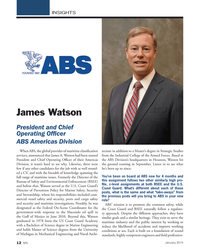 )
January 2014 - Marine News page: 12
)
January 2014 - Marine News page: 12INSIGHTS When ABS, the global provider of maritime classifi cation services, announced that James A. Watson had been named President and Chief Operating Offi cer of their Americas Division, it wasn’t hard to see why. Likewise, there were few if any other candidates for the job with as well round- ed
-
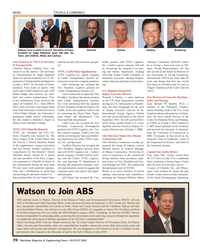 )
August 2013 - Maritime Reporter and Engineering News page: 70
)
August 2013 - Maritime Reporter and Engineering News page: 70of Trans- portation by Judge Nathaniel Jones with wife, Sa- mara, and children, Hillary and Zachary. Chiarello CarlsonWatson to Join ABS ABS said that James A. Watson, Director of the Bureau of Safety and Environmental Enforcement (BSEE), will join ABS as President and Chief Operating OfÞ cer of the Americas
-
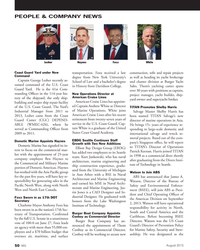 )
August 2013 - Marine News page: 50
)
August 2013 - Marine News page: 50in 1998 as a commercial diver shortly after graduating from the Divers Insti- tute of Technology in Seattle. Watson to Join ABS ABS has announced that James A. Watson, Director of the Bureau of Safety and Environmental Enforce- ment (BSEE), will join ABS as Presi- dent and Chief Operating Of? cer of
-
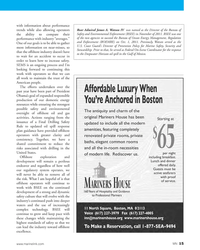 )
December 2012 - Marine News page: 15
)
December 2012 - Marine News page: 15keep pace with these changes while maintaining the highest standards of safety so that we can lead the industry toward offshore excellence. Rear Admiral James A. Watson IV was named as the Director of the Bureau of Safety and Environmental Enforcement (BSEE) in November of 2011. BSEE was one of the two
-
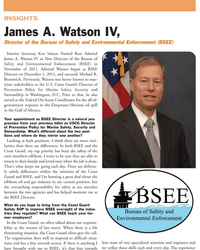 )
April 2012 - Marine News page: 10
)
April 2012 - Marine News page: 10INSIGHTSJames A. Watson IV, Director of the Bureau of Safety and Environmental Enforcement (BSEE)Interior Secretary Ken Salazar Named Rear Admiral James A. Watson IV as New Director of the Bureau of Safety and Environmental Enforcement (BSEE) in November of 2011. Admiral Watson began as BSEE Director on
-
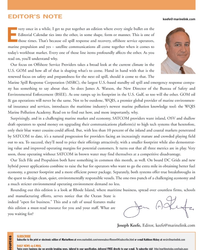 )
April 2012 - Marine News page: 6
)
April 2012 - Marine News page: 6Spill Response Corporation (MSRC), the largest U.S.-based standby oil spill and emergency response compa- ny has something to say about that. So does James A. Watson, the New Director of the Bureau of Safety and Environmental Enforcement (BSEE). As one ramps up its footprint in the U.S. Gulf, so too will
-
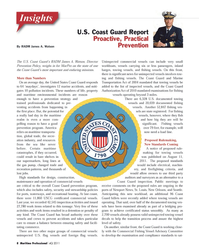 )
Q4 2011 - Maritime Logistics Professional page: 8
)
Q4 2011 - Maritime Logistics Professional page: 88 Maritime Professional 4Q 2011The U.S. Coast Guard?s RADM James A. Watson, Director Prevention Policy, weighs in for MarPro on the state of one the Coast Guard?s most important and enduring missions. More than Numbers On an average day, the United States Coast Guard responds to 64 ?maydays?, investigates
-
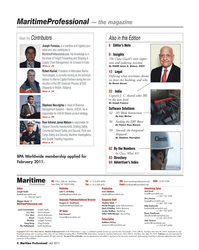 )
Q4 2011 - Maritime Logistics Professional page: 4
)
Q4 2011 - Maritime Logistics Professional page: 4? the magazine4 Maritime Professional 4Q 2011Also in this Edition6 Editor?s Note 8InsightsThe Coast Guard?s most impor- tant and enduring missions.By RADM James A. Watson, USCG12LegalDefining what constitutes domes- tic Jones Act building, and why. By Dennis Bryant22IndiaCaptain J. C. Anand takes IRS to the
